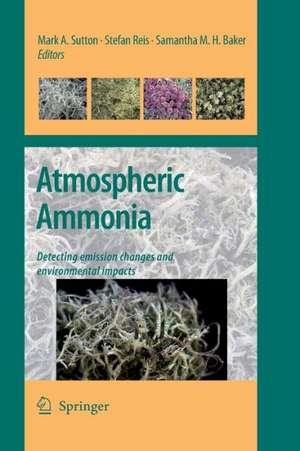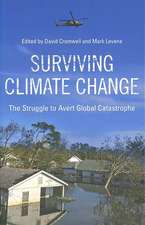Atmospheric Ammonia: Detecting emission changes and environmental impacts. Results of an Expert Workshop under the Convention on Long-range Transboundary Air Pollution
Editat de Mark Sutton, Stefan Reis, Samantha Bakeren Limba Engleză Paperback – 12 sep 2014
| Toate formatele și edițiile | Preț | Express |
|---|---|---|
| Paperback (1) | 953.65 lei 6-8 săpt. | |
| SPRINGER NETHERLANDS – 12 sep 2014 | 953.65 lei 6-8 săpt. | |
| Hardback (1) | 962.35 lei 6-8 săpt. | |
| SPRINGER NETHERLANDS – 22 dec 2008 | 962.35 lei 6-8 săpt. |
Preț: 953.65 lei
Preț vechi: 1162.99 lei
-18% Nou
Puncte Express: 1430
Preț estimativ în valută:
182.50€ • 190.29$ • 151.68£
182.50€ • 190.29$ • 151.68£
Carte tipărită la comandă
Livrare economică 21 martie-04 aprilie
Preluare comenzi: 021 569.72.76
Specificații
ISBN-13: 9789400789531
ISBN-10: 940078953X
Pagini: 492
Ilustrații: XXIII, 464 p.
Dimensiuni: 155 x 235 x 26 mm
Greutate: 0.68 kg
Ediția:2009
Editura: SPRINGER NETHERLANDS
Colecția Springer
Locul publicării:Dordrecht, Netherlands
ISBN-10: 940078953X
Pagini: 492
Ilustrații: XXIII, 464 p.
Dimensiuni: 155 x 235 x 26 mm
Greutate: 0.68 kg
Ediția:2009
Editura: SPRINGER NETHERLANDS
Colecția Springer
Locul publicării:Dordrecht, Netherlands
Public țintă
Professional/practitionerCuprins
Ammonia Critical Thresholds.- Reassessment of Critical Levels for Atmospheric Ammonia.- Potential for the Further Development and Application of Critical Levels to Assess the Environmental Impacts of Ammonia.- Long-Term Cumulative Exposure Exacerbates the Effects of Atmospheric Ammonia on an Ombrotrophic Bog: Implications for Critical Levels.- The Application of Transects to Assess the Effects of Ammonia on Woodland Groundflora.- Estimation of the Ammonia Critical Level for Epiphytic Lichens Based on Observations at Farm, Landscape and National Scales.- Mapping Ammonia Emissions and Concentrations for Switzerland — Effects on Lichen Vegetation.- Over Which Averaging Period is the Ammonia Critical Level Most Precautionary?.- Macrolichens on Twigs and Trunks as Indicators of Ammonia Concentrations Across the UK — a Practical Method.- Assessment of Critical Levels of Atmospheric Ammonia for Lichen Diversity in Cork-Oak Woodland, Portugal.- Temporal Trends in Atmospheric Ammonia.- Linking Ammonia Emission Trends to Measured Concentrations and Deposition of Reduced Nitrogen at Different Scales.- Long-Term Record (1981—2005) of Ammonia and Ammonium Concentrations at K-Puszta Hungary and the Effect of Sulphur Dioxide Emission Change on Measured and Modelled Concentrations.- Assessment of Ammonia and Ammonium Trends and Relationship to Critical Levels in the UK National Ammonia Monitoring Network (NAMN).- Review of Published Studies Estimating the Abatement Efficacy of Reduced-Emission Slurry Spreading Techniques.- Analysis of Ammonia Hotspots.- Ammonia Deposition Near Hot Spots: Processes, Models and Monitoring Methods.- Standardised Grasses as Biomonitors of Ammonia Pollution Around Agricultural Point Sources.- Soluble Ammonium in Plants as a Bioindicator forAtmospheric Nitrogen Deposition: Refinement and Testing of a Practical Method.- Spatial Planning as a Complementary Tool to Abate the Effects of Atmospheric Ammonia Deposition at the Landscape Scale.- Regional Modelling of Atmospheric Ammonia.- Modelling of the Atmospheric Transport and Deposition of Ammonia at a National and Regional Scale.- Application of a Lagrangian Model FRAME to Estimate Reduced Nitrogen Deposition and Ammonia Concentrations in Poland.- Application of the EMEP Unified Model to the UK with a Horizontal Resolution of 5 × 5 km2.- Conclusions and Outlook.- Critical Levels for Ammonia.- Detecting Change in Atmospheric Ammonia Following Emission Changes.- Assessment Methods for Ammonia Hot-Spots.- Modelling the National and Regional Transport and Deposition of Ammonia.- Reliability of Ammonia Emission Estimates and Abatement Efficiencies.- Ammonia Policy Context and Future Challenges.- Synthesis and Summary for Policy Makers.
Notă biografică
Mark Sutton
Is a specialist in the behaviour of ammonia in the atmosphere, based at the NERC Centre for Ecology and Hydrology, Edinburgh. He is the coordinator of the NitroEurope Integrated Project, chairman of the European Centre of the International Nitrogen Initiative and co-chair of the UNECE Task Force on Reactive Nitrogen.
Stefan Reis
Is an expert on emissions of atmospheric pollutants and integrated assessment modelling. Formerly of the Institute of Energy Economics and the Rational Use of Energy at the University of Stuttgart, Germany, he is now the Scientific Project Manager of the NitroEurope Integrated Project.
Samantha Baker
Is a scientific policy analyst at the UK Department for Environment Food and Rural Affairs (Defra), with extensive experience of transboundary air pollution issues. She and a member of the Natural Resource and Rural Affairs (NRRA) Science Division at Defra and co-chairs the Projections Panel of the UNECE Task Force on Emission Inventories and Projections.
Is a specialist in the behaviour of ammonia in the atmosphere, based at the NERC Centre for Ecology and Hydrology, Edinburgh. He is the coordinator of the NitroEurope Integrated Project, chairman of the European Centre of the International Nitrogen Initiative and co-chair of the UNECE Task Force on Reactive Nitrogen.
Stefan Reis
Is an expert on emissions of atmospheric pollutants and integrated assessment modelling. Formerly of the Institute of Energy Economics and the Rational Use of Energy at the University of Stuttgart, Germany, he is now the Scientific Project Manager of the NitroEurope Integrated Project.
Samantha Baker
Is a scientific policy analyst at the UK Department for Environment Food and Rural Affairs (Defra), with extensive experience of transboundary air pollution issues. She and a member of the Natural Resource and Rural Affairs (NRRA) Science Division at Defra and co-chairs the Projections Panel of the UNECE Task Force on Emission Inventories and Projections.
Textul de pe ultima copertă
Atmospheric ammonia is increasingly being recognized as a pollutant of key environmental concern. Ammonia contributes to several environmental problems, including direct toxic effects on vegetation, atmospheric nitrogen deposition, leading to the eutrophication and acidification of sensitive ecosystem, and to the formation of secondary particulate matter in the atmosphere, with effects on human health, atmospheric visibility and global radiative balance. Ammonia emissions are increasing rapidly in many parts of the world, so that these environmental concerns are expected to grow in future. In Europe, efforts are currently being made to reduce ammonia emissions, alongside reductions in other air pollutants, notably sulphur dioxide and nitrogen oxides. However, reducing ammonia emissions has proved uncertain and challenging, with only modest regional reductions achieved to date. As the emissions of sulphur dioxide and nitrogen oxides are reduced, ammonia is therefore increasingly dominating the air pollution climate of Europe and the consequent environmental impacts.
It was in this context that the leading international experts met in Edinburgh in December 2006 under the auspices of the UN-ECE Convention on Long Range Transboundary Air Pollution to review the current state of the science of ammonia in the atmosphere. Specifically, the international workshop was a joint effort between several bodies of the Convention: the Ammonia Expert Group, the Working Group on Effects and the Task Force on Measurement and Modelling, together with the COST 729 and the NitroEurope Integrated Project. This book reports the underpinning information in the form of several major reviews, combined with supporting chapters on recent research results, to provide an up-to-date scientific synthesis in relation to four key themes:
This book will be valuable to all those interested in the behaviour of ammonia in the environment, as it explains the current state of knowledge, reports new critical level values, and describes the main scientific uncertainties.
It was in this context that the leading international experts met in Edinburgh in December 2006 under the auspices of the UN-ECE Convention on Long Range Transboundary Air Pollution to review the current state of the science of ammonia in the atmosphere. Specifically, the international workshop was a joint effort between several bodies of the Convention: the Ammonia Expert Group, the Working Group on Effects and the Task Force on Measurement and Modelling, together with the COST 729 and the NitroEurope Integrated Project. This book reports the underpinning information in the form of several major reviews, combined with supporting chapters on recent research results, to provide an up-to-date scientific synthesis in relation to four key themes:
- Re-evaluation of the critical thresholds for ammonia effects on sensitive plants and habitats
- Review of approaches for downscaling transboundary assessments to deal with ammonia hotspots in relation to operational modelling and monitoring
- Review of regional scale atmospheric transport and chemistry models in relation to their formulation and results for ammonia.
This book will be valuable to all those interested in the behaviour of ammonia in the environment, as it explains the current state of knowledge, reports new critical level values, and describes the main scientific uncertainties.
Caracteristici
Explains the current state of knowledge of the behaviour of ammonia in the environment Reports new critical level values










